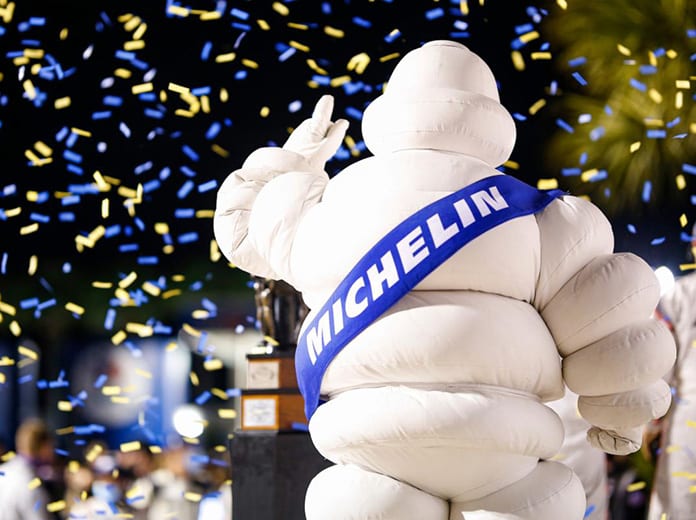DAYTONA BEACH, Fla. – It’s one thing to say Michelin is an official partner of IMSA. In this day and age, there are scores of official partners for every professional sports property, be it league, team or event.
But scratch the surface of IMSA even slightly and you’ll find Michelin all around the IMSA paddock and across venues and events. From Michelin Raceway Road Atlanta, site of the famous Motul Petit Le Mans, to the Michelin GT Challenge at VIRginia Int’l Raceway.
Go deeper in 2020 and you’d find Michelin tires on all four corners of every car competing in the IMSA Michelin Pilot Challenge and IMSA Prototype Challenge as well as the Daytona Prototype international (DPi), Le Mans Prototype 2 (LMP2) and GT Daytona (GTD) classes of the IMSA WeatherTech SportsCar Championship. And while the series’ GT Le Mans (GTLM) class remains an open tire category, currently all the entrants rely on Michelin where rubber contacts pavement.
Supplying tires to all those cars for events lasting from 100 minutes to 24 hours makes for some impressive preparation and numbers. Especially with conditions ranging from the searing heat of a Florida afternoon to the chill of an autumn evening in Georgia, with the chance of rain never to be discounted.
“The number of tires taken (to an event) is always a certain percentage beyond what the expectation is,” says Tom Sullivan, motorsports marketing manager for Michelin North America, “and you have to be prepared for wet weather. In fact, you have to be prepared for Daytona and Sebring being entirely wet.”
Making things slightly easier for Michelin, when it comes to tires, there are no in-betweens in IMSA. It’s either slicks for dry weather or full-grooved rain tires – no intermediates. Nevertheless, that still means bringing enough wet-weather tires to supply the entire field at Daytona International Speedway and Sebring International Raceway for 24 and 12 hours, respectively, all the while knowing the races may well be bone dry from start to finish.
When it comes to slick tires, in the Pilot Challenge and the DPi, LMP2 and GTD classes of the WeatherTech Championship, Michelin works in concert with IMSA to determine in advance which of two different compounds to supply competitors. Traditionally, they opt for a softer compound for the cooler early-season races while running a harder-compound tire in the warmer mid-season races. On the other hand, Michelin supplies Le Mans Prototype 3 (LMP3) competitors in the Prototype Challenge with the same compound all year, albeit a combination of soft-compound front tires and harder-compound rear tires.
Things get considerably more complicated in GTLM, where Michelin works with the participating car manufacturers to design and produce proprietary soft- and hard-compound slicks tailored to the performance characteristics of each car. What’s more, teams are free to mix and match compounds on all four corners of the car, for example, choosing to run soft-compound Michelins on the front and hard compounds on the rear or even different compounds from side to side.
That all adds up to lots of tires. Ken Payne, Michelin North America’s technical director of motorsport, estimated that Michelin last year took roughly 5,000 tires (including rain tires) to race weekends featuring the standard two-hour, 40-minute WeatherTech Championship events. That number shrank for race weekends with fewer classes, such as the Michelin GT Challenge at VIR that did not include the DPi and LMP2 categories.
On the other hand, Payne says Michelin brought some 12,000 tires to the 2020 Rolex 24 At Daytona. And for something completely different, consider 2019’s Super Sebring event featuring the WeatherTech Championship’s 12-hour race, Pilot Challenge, Prototype Challenge and the FIA World Endurance Championship for a 1,000-mile race.
“That was the largest event in Michelin motorsports history,” says Payne, “with 16,000 tires covering four race series, (equipping) 137 of a possible 140 cars, all operating from a 24,000-square-foot tent as part of a 27,000-square-foot workshop.”
Michelin could be looking at similar numbers or more for Sebring in March 2021. The Mobil 1 Twelve Hours of Sebring Presented by Advance Auto Parts will see an added class with the introduction of Le Mans Prototype 3 (LMP3) for the coming WeatherTech Championship campaign. The WEC season is slated to open with the 1000 Miles of Sebring. Pilot Challenge and Prototype Challenge races are on the docket as well. Plus, Michelin is outfitting the field for the Porsche Carrera Cup North America series that makes its debut at Sebring.
It’s a massive undertaking but one that Michelin has handled with precision in the past, the same meticulousness that the tire manufacturer brings to each and every IMSA event.
